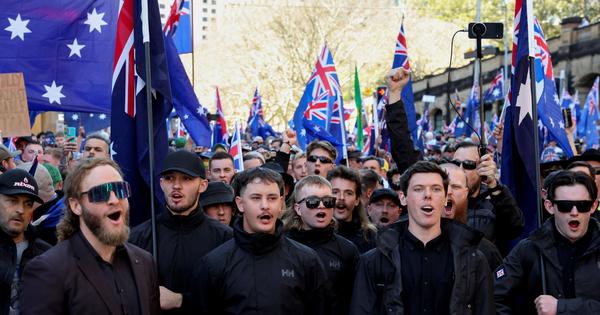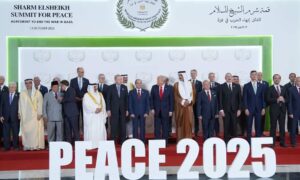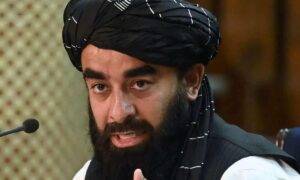
As the fallout from the so-called March For Australia rallies continues, many observers are saying Australia has reached a turning point, suggesting the weekend’s events signal a new era of far-right normalisation and political violence.
Given the overt racism of the event and the neo-Nazi attack on Camp Sovereignty, this is entirely understandable.
A deeper, more difficult, truth
However, we should be careful about framing March For Australia as an aberration. Portraying these rallies as something new and unusual prevents us from understanding how this situation arose in the first place. This includes the unpalatable truth of ongoing racism and ethnic nationalism in Australia.
March For Australia is not exceptional, nor did it occur in a vacuum.
Consider the similarity between March For Australia and other events here and abroad, such as the Cronulla riots, the English Defence League’s activities in the 2010s, the Unite the Right rally in Charlottesville in 2017, the US Capitol riots of 2021, and last year’s London riots – to name just a few.
Consider also the similarity between the groups involved in March For Australia and other far-right groups such as the Australian Defence League, Reclaim Australia, United Patriots Front, True Blue Crew and Lads Society, as well as their counterparts overseas, such as the English Defence League, Proud Boys, and many more.
These groups often exist for a period and then disband, only to pop up later under another name. Neo-Nazi leader Thomas Sewell, for example, was previously a member of the UPF, Reclaim Australia, Lads Society and Antipodean Resistance.
While opportunistic, this shows that March For Australia did not emerge spontaneously.
Crucially, its emergence also cannot be explained solely in reference to so-called “extreme” events and actors.
There is a much longer and broader history here.
In recent days we have been inundated with terms such as “far right”, “extreme”, “extremists”, “radical”, “neo-Nazis” and “fascism”. This is understandable because the events we saw over the weekend were shocking for many people and literally involved neo-Nazis.
That said, an unintended consequence of this language can be that it portrays events such as March For Australia as if they originate and subsist only in the margins of society. This lets “mainstream” Australia off too lightly.
Contagion thesis
We can see this problem not only in public discussion, but also in research on the far right. For example, the idea that far-right actors are increasingly infiltrating the public sphere is sometimes called “the contagion thesis”, which describes a situation in which “fringe” actors come from outside to contaminate and occupy the centre of society.
We have seen this used to explain March For Australia, where it has been said white supremacist groups like the Nationalist Socialist Network “took over” the march and used it as a recruitment opportunity. In other words, it supposedly acted as a contagion on the “legitimate” concerns of everyday “mum and dad” protesters.
While it’s important to call out white supremacists and neo-Nazis, the problem with doing it in this way is that it makes them solely responsible for all the overt racism and ethnic nationalism that played out during the march. This provides cover to other participants by obscuring the prevalence of racism and ethnic nationalism in Australia. It also covers the extent to which their supposedly “legitimate” grievances are in fact in line with white supremacy.
Polarisation and social cohesion
“Polarisation” is also a term frequently used in public debate and far-right research. The idea is that society is increasingly dominated by forces at opposite ends of the political spectrum, moving further away from each other. The implication is that the shift away from the “sensible centre” is causing a lack of social cohesion and increased conflict in society.
An example of this can be seen in the way many are framing the violence of March For Australia in terms of clashes between “protesters” and “counter-protesters” (namely, those who participated in the march and the Pro-Palestine and anti-fascist movements that opposed them).
The problem is this language suggests there are two comparable sides that are both supposedly equally “extreme” and distant from a “sensible” middle ground.
It also leads to the liberal conclusion that what is needed is a “return” to the centre and “social cohesion”. This too provides an alibi to normalised racism and ethnic nationalism that has always been central to Australia.
The role of mainstream media
Academics concerned with this area of politics have explored how liberal democracies can not only fail to act as a buffer against the far right, but can actually be conducive to it.
In my own work, I have argued we need to contend with the proximity of the far right, as well as account for the role of not only racism and overt ethnic nationalism, but “everyday” and banal forms of nationalism as well.
This is because nationalism is always predicated on maintaining the idea that there are two groups: those on the inside and those on the outside. As is so often the case, the reality is far more complicated.
March For Australia, and the overt racism that went with it, cannot be explained away as some new or unexpected phenomenon. It is also not one for which only a select few “extreme” groups or people are primarily responsible. We simply have too much historical evidence that points otherwise.
We have to acknowledge that “mainstream” Australia is also implicated.
Liam Gillespie is Lecturer in Criminology, The University of Melbourne
This article was first published on The Conversation.
This article first appeared on Scroll.in
📰 Crime Today News is proudly sponsored by DRYFRUIT & CO – A Brand by eFabby Global LLC
Design & Developed by Yes Mom Hosting






